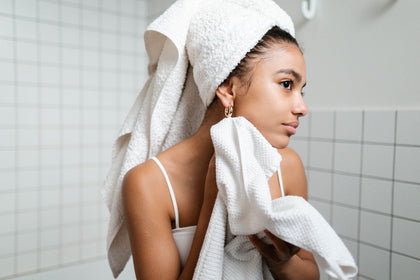It's completely normal to lose what looks like a lot of hair when you shower. Whether you believe it or not, strands clinging to your fingers and hair sitting in the drain are a natural part of the hair growth cycle. Most of the time, there's nothing to worry about. But what if you think this hair falling is excessive? How much hair is normal to lose in the shower?
VEGAMOUR spoke with a dermatologist about shower hair loss and what's normal. Plus, we'll share what products you can use to encourage thicker looking hair.
How Hair Grows
Hairs go through a series of phases within the hair cycle. During the anagen cycle, hairs are "born" from the hair follicles and grow for a period of two to six years. The catagen phase is a brief transition phase when the hair stops growing; it takes place between the growth and the shedding stage. A second brief phase, called the telogen phase, then occurs, which is a resting phase for the hair as your body prepares to shed old hairs. The exogen phase is when the hairs are finally shed from your scalp.
@vegamour How much hair is normal to lose in the shower? We’re here to tell you why! 💛 #vegamour #LetsGROtogether #hairtok #hairwellness #cleanbeauty #hairlossjourney ♬ smiles & sunsets - ultmt.
The telogen phase affects less than 10% of the hairs on your scalp at a time, leading up to when the hairs are shed. Most of the time, most of your hair is in the anagen phase of growth.
However, hairs can be forced to move into the shedding phase more quickly than what's normal for you, due to medical conditions, genetics, stress levels or environmental factors, which can result in excessive hair loss that can lead to hair thinning. If this excess loss goes on for too long, it can lead to thinning of the hair or even baldness.
Shop: GRO Collection for Thinning Hair
Normal Hair Loss in the Shower
When you shampoo your hair in the shower, hair fall is a little more noticeable because it clings to your fingers and piles up in the drain. It can be upsetting to see those loose strands, especially if you come from a long family line of people who have suffered visible hair thinning.
VEGAMOUR spoke with Dr. Crystal Dinopol, DPDS, board-certified dermatologist who explained, "The average daily hair loss should be anywhere from 100- 200 hairs daily. It's rather difficult to count, and it may seem like a lot, but it also largely depends on what type of hair products you use, heat styling, hormonal status, medications, scalp disorders etc."
Dinopol shared that while this amount of hair fall might seem alarming, "In general, if you don't find any bald spots or thinning hair, then chances are you are having the normal amount of daily hair fall."
Also: How Much Hair Loss Is Normal?
Contributing Factors to Hair Shed
As Dinopol said, there are reasons you might see more hair loss, particularly in the shower. Here are some examples.
- You've been taking fewer showers, which means you might see more days' worth of hair loss in the shower.
- You do not brush your hair before you get in the shower, so your hair doesn't come out in your brush but as you shampoo it in the shower. To minimize this, use a bristle brush to remove shed hairs before you get into the shower.
- You're under an amplified amount of stress. This can impact your hair loss causing a condition called telogen effluvium.
Certain health conditions could also play a role in hair loss.
- Hormonal changes
- Rapid weight loss
- A hair loss condition, such as alopecia areata or telogen effluvium. Additionally, androgenetic alopecia —aka male or female pattern baldness or female pattern hair loss — can present as a gradual and even hair thinning.
- Stress to your immune system that's pushing your hair out of the active growth phase.
- Thyroid condition or thyroid disease
- Physical changes that affect your scalp like the rise in DHT.
Related: What Causes Hair Loss? Every Trigger Explained
When Should You Worry?
It's normal to feel anxious about hair loss. So, how do you know if your hair is exhibiting the normal phase of shedding related to the hair cycle, if there's hair breakage or if your hair's actually thinning out? Will there be permanent hair loss? Is there something you can do to reduce hair shedding?
Fortunately, there are some things you can do to slow down amplified hair loss and improve your hair's health. In the meantime, unless you are seeing visible hair thinning or bald patches, try not to worry too much because increased stress can make hair loss worse. If you are seeing visible hair thinning and bald patches, consult with the doctor to find out the cause.
Read: Seasonal Hair Loss Explained
Ways to Improve Hair Health
Anytime you notice your hair falling out more than normal, you'll want to ramp up your self-care for your whole body. Here are some helpful suggestions.
Eat a Nutritious Diet and Stay Hydrated
Consider a few changes to your pantry. Stock your kitchen with lots of fresh fruits and veggies for the vitamins and minerals your body needs. Also considering fortifying your diet with hair-healthy gummies that contain vitamins A, C and E and a host of B vitamins, plus folic acid and zinc. They're a naturally sweet way to treat yourself (and your scalp), and encourage fuller, thicker-looking hair. Also, make sure to drink plenty of water to stay hydrated.
Find Out: Can Dehydration Cause Hair Loss?
Get Enough Exercise and Sleep
Exercise to help you destress; even regular walks outdoors can help. Also, remember to get plenty of quality sleep to help your body to fight stress and be at its best.
Replace Hair Products
Get rid of hair products with harsh ingredients, and opt for those that are plant-based. Start with GRO Revitalizing Shampoo and Conditioner (it smells divine!), which is formulated with powerful phyto-actives to encourage visibly denser hair.
Practice Smart Styling
Reduce wear-and-tear on your hair with these smart styling tips.
- If you've been pulling your hair too tight for braids or ponytails, it can cause traction hair loss. Loosen up any pull on the scalp from hair styling and give your scalp a break from all that tension.
- If you're using a small-toothed comb or a bristle brush in the shower swap those out for a wide-tooth comb, which is much more gentle on wet hair.
- If you blow dry regularly, try skipping the blow drying a few times a week to minimize heat damage.
- Use styling products without silicones, which can build up on the hair, or alcohols, which can dry out the hair's natural oils.
A Holistic Approach Can Help Your Hair Thrive
The best approach to healthy hair that doesn't shed excessively is a holistic approach. Strive to eat right, stay hydrated, reduce stress, get plenty of sleep and use gentle hair care products and practices.
#include-related-slider#
More From VEGAMOUR
- Shop: Shampoos for Thinning Hair
-
Look Out for These 7 Signs of Balding
- Can Intermittent Fasting Cause Hair Loss?
- How to Care for Thinning Hair
Photo credit: Ron Lach/Pexels




















